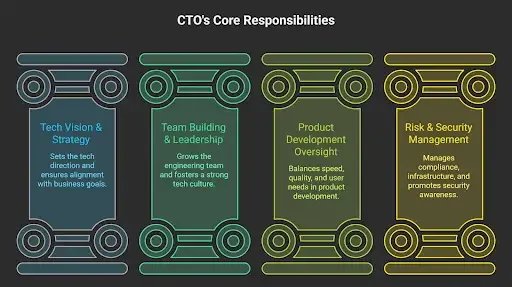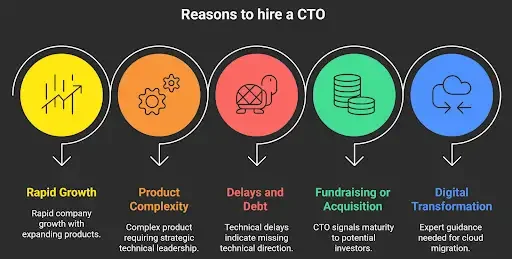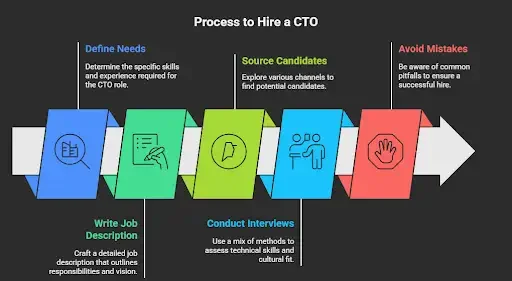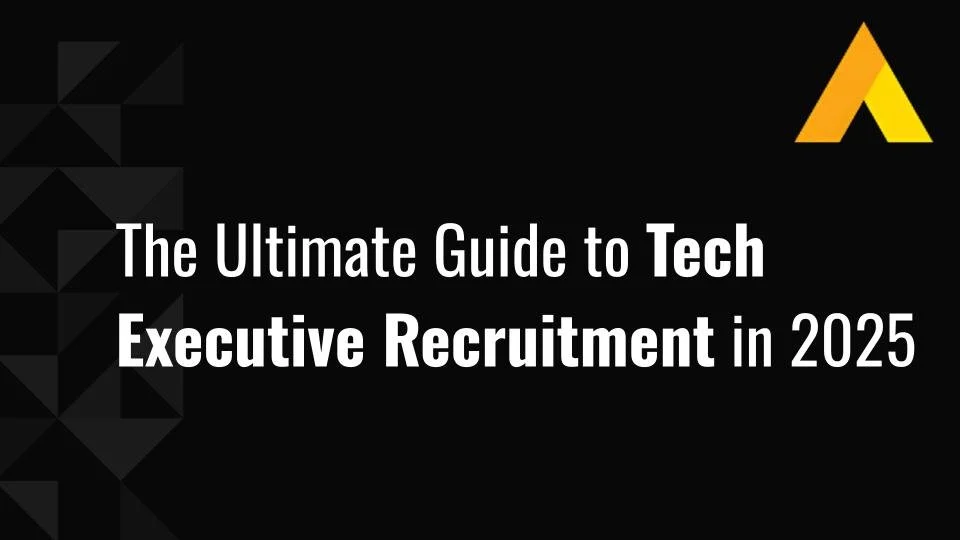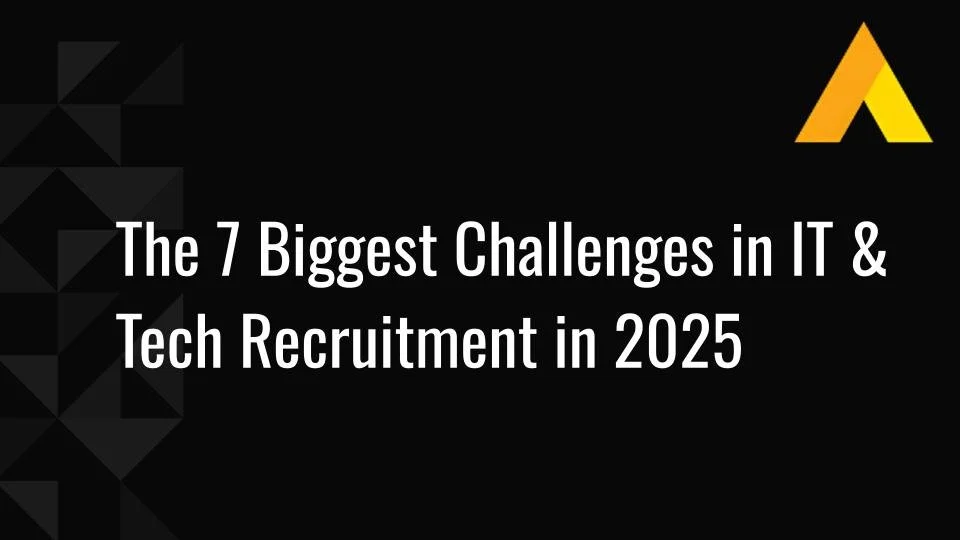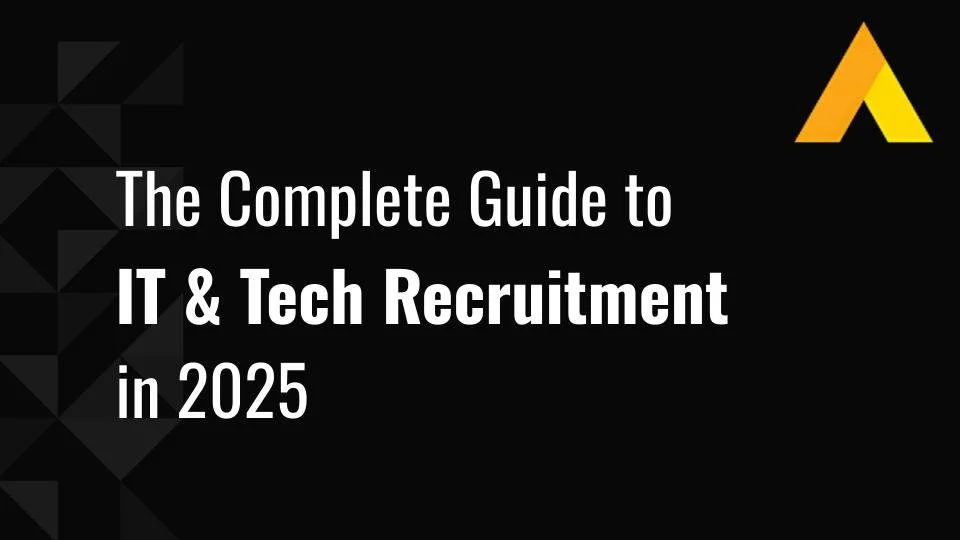Hiring a CTO: A Strategic Guide for Growth-Ready Companies
Hiring a CTO is a big step forward. For companies building a digital product or scaling their tech infrastructure, this role plays an important part in shaping their future.
A strong CTO brings technical leadership and the much-needed support to an overworked engineering team to drive real, measurable outcomes.
However, securing the right hire is far from simple.
The market is crowded with candidates but thin at the top. Executive search firms reported over 2,700 new CTO searches in the U.S. last year, showing that competition for proven technology leaders remains intense.
This guide explores when to bring on a CTO, what responsibilities the role should cover, and how to identify someone who aligns with your growth strategy AND your tech stack.
Let’s dive in.
TL;DR
If you’re short on time, here’s the summary:
A CTO defines your tech vision, builds the engineering team, and keeps your infrastructure secure.
The ideal time to hire is during scaling, complex product builds, or digital transformation.
Don’t just hire for code. Leadership, strategy, and communication are just as important.
Top challenges: 69% of leaders report longer hiring timelines, and 45% say competition is rising.
Look for a mix of technical depth, business acumen, and cultural alignment.
Best channels to find CTOs: referrals, niche networks, and executive search firms.
Fractional CTOs work well for early-stage or budget-limited companies.
Define your needs clearly before starting the search. Avoid rushing or over-indexing on technical skills.
What Does a CTO Do?
The title "Chief Technology Officer" has different meanings depending on the company's size, stage, and product complexity. But across the board, this role combines technical authority with long-term strategy and leadership.
Here’s what that typically looks like:
Technology Strategy and Vision
The CTO leads all major technical decisions. This includes selecting the right architecture, establishing coding standards, and ensuring that every tech initiative aligns with the business roadmap.
A strong CTO serves as a filter for technological noise. For example, while AI tools are trending, they’ll only advocate for adoption if they directly support your objectives.
Right now, cloud computing tops the list of essentials. According to STX Next’s Global CTO Survey, 83.5 % of CTOs list it as a core part of their infrastructure strategy.
Building and Leading the Tech Team
A CTO is responsible for the growth, structure, and output of your entire engineering organization. They define roles, identify leadership potential, and build a performance-driven culture.
As also noted in STX Next's survey, 81.3% of CTOs say they evaluate teams based on quality of output, not just speed or hours worked. Communication, attitude, and technical skills are also top priorities.
This kind of leadership becomes critical as your development team expands and product complexity increases.
Product Development Oversight
The CTO works closely with product leadership to prioritize the roadmap, define requirements, and make sure what gets built is aligned with user and business needs.
They also determine how fast your team can move without sacrificing code quality or maintainability. Flexible practices are common here, with over 70% of CTOs using them to manage product delivery efficiently.
This balance of speed and stability directly impacts time-to-market and user experience.
Risk Management and Security
From cloud architecture to regulatory compliance, a CTO is the gatekeeper for technical risk.
That includes security audits, data governance, infrastructure resilience, and employee training. Today, 64% of companies require mandatory cybersecurity training. Still, human error remains the leading concern, cited by 45.1% of respondents.
A strong CTO doesn’t wait for a breach to address vulnerabilities. They build a risk-aware culture and systems that are prepared for scale.
Why Is Hiring a CTO so Important?
A CTO shapes how a company scales, competes, and innovates. The role goes beyond clean code or system design; they also make long-term choices that define market position, resilience, and the ability to attract top talent.
Also, strong CTOs lead with vision.
They bridge engineering and business, turn goals into actionable roadmaps, and quickly spot when tech is slowing growth or resources are being misused.
The difference is visible in outcomes.
Companies with strategic CTO leadership consistently outperform those without it. In fact, only 50% of tech firms met their hiring goals in 2024, as noted by GoodTime, a sign that weak technical leadership often leads to misalignment and missed targets.
By contrast, organizations with a clear technical strategy hire more effectively, scale faster, and innovate with less friction. They cut down technical debt, make smarter decisions, and attract engineers eager to build rather than maintain outdated systems.
When Should Your Company Consider Hiring a CTO?
Bringing in a CTO too early can waste time and budget. But waiting too long can stall growth and create avoidable risk.
So when’s the right time? Well, here are the signals to watch for:
Your company is scaling fast: If your development team is growing beyond 5–10 engineers, or you're adding new products or markets, you need strategic tech leadership.
Your product is becoming more complex: Integrating AI, expanding to mobile, or managing multiple codebases requires someone who can handle cross-functional planning.
You’re facing tech debt or delivery delays: These are usually symptoms of missing leadership, unclear ownership, or outdated infrastructure.
You’re preparing for fundraising or acquisition: Investors will want to see a strong technology org, and having a CTO on board signals maturity.
You're planning a digital transformation: If you're overhauling systems, migrating to the cloud, or updating your IT strategy, a CTO ensures you're not building on shaky ground.
The stage of your company matters too. Early-stage startups may start with a hands-on technical co-founder or a fractional CTO. Later-stage companies typically need a full-time executive who can handle infrastructure decisions, team scaling, and product evolution.
What matters most is timing your hire around clear operational needs, not titles, trends, or investor pressure.
Pro tip: Not sure how to time or structure a senior tech hire? Check out our guide to tech executive recruitment for deeper insights on planning and executing high-level technology searches.
What Qualities Should You Look for When Hiring a CTO?
Hiring a CTO means betting on both technical depth and leadership potential. The wrong hire can slow your product, drain resources, and push your team toward burnout. The right one gives you scalability, innovation, and stability.
Here are the qualities that define a strong Chief Technology Officer:
Technical Expertise vs. Leadership Ability
A CTO should understand software architecture, system design, and technology infrastructure at a level that earns the respect of engineers. According to STX Next’s Global CTO Survey, 64.8% of CTOs come from software engineering backgrounds. That foundation matters when leading technical discussions.
But technical depth alone isn’t enough.
As the same survey stated, 77% of CTOs actually transitioned into the role from engineering management or technical leadership positions. That shift shows how important it is to combine coding credibility with the ability to lead, delegate, and think strategically.
As Camille Fournier said in her book “The Manager's Path: A Guide for Tech Leaders Navigating Growth and Change:”
“The CTO who doesn’t also have the authority of management must be able to get things done purely by influencing the organization. If the managers won’t actually give people and time to work on the areas that the CTO believes are important, he is rendered effectively powerless.” (Camille Fournier)
Communication and Stakeholder Management
A CTO sits at the intersection of technology and business. They need to explain system architecture to non-technical executives, translate product requirements into technical tasks, and align cross-functional teams.
This is one of the most underestimated skills. Most of the CTOs say that communication is essential for their role, ranking it even above technical expertise. Without it, the gap between leadership teams and engineering widens, and priorities start to fall apart.
Adaptability and Future Vision
Technology changes fast. Companies adopting cloud infrastructure, AI, or microservices gain a competitive edge only if their leadership can adapt. STX Next's survey shows that 71.4% of CTOs expect machine learning to reshape their work in the next 2–4 years.
An effective CTO focuses on what drives real value, separating short-lived trends from strategic priorities and ensuring the company is prepared for immediate needs as well as long-term growth.
As Mira Murati, Chief Technology Officer of OpenAI said:
“This is a unique moment in time where we do have agency in how (AI) shapes society. And it goes both ways: the technology shapes us and we shape it.” (Mira Murati)
Cultural Fit and Values
Culture is where even technically brilliant hires can fail. A CTO sets the tone for the engineering team. If their values don’t match the organization’s, friction builds quickly.
According to the STX Next survey, 79.1% of companies weigh cultural fit equally with technical skills when hiring a CTO. That’s because a technical strategy without cultural alignment creates silos instead of collaboration.
The right hire strengthens your company culture. They attract engineers who want to work in an environment of ownership, transparency, and accountability. And that translates directly into long-term performance.
Pro tip: Want a shortlist of leaders who fit from day one? Alpha Apex Group's proprietary platform draws over 400 qualified candidate inquiries daily, giving us unmatched reach to find CTOs who align with both culture and technical goals.
How Do You Structure the Hiring CTO Process?
Hiring a CTO is different from filling a mid-level engineering role. The process requires clarity, patience, and the right sourcing strategy.
Companies that rush into it often end up restarting the search within a year, which drives up both cost and frustration. A structured approach saves time and ensures alignment.
Defining Your Needs Clearly
First off, identify what your company actually needs. A startup looking for MVP development and rapid iteration doesn’t require the same CTO profile as an enterprise managing global infrastructure.
From our experience, early-stage companies usually prioritize hands-on builders who can code alongside the team. Later-stage businesses need executives who can lead at scale, set an IT governance framework, and handle compliance.
Clarity at this step prevents mismatched hires.
Writing the Right Job Description
A strong job description does more than list skills. It communicates the role’s scope, expectations, and impact. So, be clear about responsibilities such as building the engineering headcount, setting the technology strategy, and overseeing security standards.
Including specific keywords like “system architecture,” “AI solutions,” or “digital transformation initiatives” also makes your posting easier to find through recruitment firms and job boards.
Where to Find CTO Candidates
Finding a CTO requires more targeted outreach than regular engineering roles. The best sources are:
Employee referrals (account for 57.1% of successful CTO hires, according to STX Next).
Executive search firms specializing in technology leadership.
Niche job boards focused on engineering executives.
Industry networks and private communities for senior tech leaders.
This is one role where passive candidates typically outperform active job seekers.
Interviewing and Assessment Methods
The final step is evaluating both technical credibility and leadership potential. A well-rounded process typically includes:
Technical assessments or architecture reviews.
Leadership case studies focused on scaling teams or resolving delivery issues.
Cultural fit, interviews with other executives and board members.
The goal is to see how candidates make decisions when the pressure’s on, how they balance speed with long-term stability, and how well their approach aligns with the culture of your product development team.
A structured process reduces hiring risks and builds confidence that your new CTO will deliver from day one.
Pro Tip: Need a faster, data-backed CTO search? Alpha Apex Group averages 55–90 days to place top executives (well below the 120+ day industry norm) by combining targeted outreach with a proven candidate engagement model.
What are the Biggest Mistakes Companies Make When Hiring a CTO?
Hiring a CTO is a high-stakes decision. The right choice lays the foundation for growth, while the wrong one leads to stalled projects, turnover, and wasted capital.
These are the most common mistakes to avoid:
Hiring Purely for Technical Skills
Strong coding ability doesn’t automatically translate into leadership. Many companies fall into the trap of choosing the “smartest engineer in the room” without assessing vision, communication, and business alignment. In a lot of cases, this results in technical silos and missed opportunities to scale effectively.
Not Aligning the Role with the Company Stage
A CTO for a five-person startup has a very different mandate than one for a later-stage company preparing for IPO. Hiring without clarity on your stage-specific needs leads to mismatched expectations on both sides.
Rushing the Process
As GoodTime also stated, 69% of leaders report longer hiring timelines, and for good reason. Executive searches take time. Rushing it leads to short-term fixes that create long-term pain.
We, at Alpha Apex Group, are 60% faster than the industry average. However, our sourcing system produces solid results: our candidate placement success rate is 80%, and, more importantly, we offer a 90-day replacement guarantee for your peace of mind.
Ignoring Cultural Fit
Culture is not a secondary factor. A CTO shapes how teams collaborate, how decisions are made, and how conflicts are resolved. Overlooking this aspect creates friction that even the strongest technical skills cannot overcome.
The bottom line: most mistakes come from treating CTO hiring like any other engineering hire. It requires a higher level of clarity, patience, and structure.
P.S.: Curious about how executive search firms help companies find the right CTO? Our guide on CTO executive search firms can help you.
Should You Consider Interim or Fractional CTOs?
Not every company is ready for a full-time Chief Technology Officer. In some cases, hiring an interim or fractional CTO is the smarter move.
Benefits of Interim or Fractional Hires
Bringing in an interim or fractional CTO can bridge the gap when you’re not ready for a permanent executive. It gives you access to senior-level expertise without committing to the full-time cost.
Cost control: Fractional CTOs provide executive-level guidance without the full-time compensation package. This helps early-stage or budget-constrained startups keep costs predictable.
Speed: They can step in quickly to handle urgent needs, like stabilizing infrastructure or guiding MVP development.
Expertise on demand: Many fractional CTOs have worked across multiple companies and bring broad experience with system architecture, cloud computing, and AI solutions.
When this Option Makes Sense
Fractional or interim CTOs are not a one-size-fits-all solution. They’re most valuable in specific scenarios where leadership is needed, but a permanent hire may be premature.
Early-stage companies that need a technical strategy but don’t yet require a permanent executive.
Startups preparing for fundraising, where a CTO-level presence helps establish credibility with investors.
Organizations facing urgent technical debt or delivery challenges that need short-term leadership while planning for a permanent hire.
Risks and Limitations
Fractional CTOs aren’t a long-term substitute for committed leadership. They may not be as invested in team culture or ongoing execution, and their availability can be limited. Over time, this creates gaps in continuity.
For companies with stable funding and long-term scaling plans, moving to a full-time Chief Technology Officer is almost always the better path.
Find the CTO Your Company Needs With an Expert Partner
Hiring a CTO is one of the most consequential decisions for any company. The right leader defines your ability to innovate, scale, and manage risk, anchoring both product development and long-term growth.
Poorly considered hires, by contrast, often result in stalled initiatives, fragmented teams, and growing technical debt.
At Alpha Apex Group, we help organizations secure technology leaders who combine technical expertise with strategic vision.
The next stage of your growth depends on the right CTO, and we’re here to ensure you find them. Contact us today to see how we can help.
FAQs
What Does a Chief Technology Officer (CTO) Do in a Company?
A CTO sets the tech strategy, leads software engineers, manages software development methodologies, ensures IT security and data security, and oversees the product development roadmap.
When is the Right Time for a Startup or Business to Hire a CTO?
Usually, when your business is scaling fast, you are pursuing product-market fit, adding mobile services, launching a digital marketplace, or running SaaS technology platforms and subscription business models.
What Skills and Qualifications Should You Look for when Hiring a CTO?
Strong technology expertise, experience with cloud providers and web development frameworks, plus leadership experience from roles like Vice President of Engineering or Head of AI.
How Much Does a CTO Typically Earn, and What Factors Affect Salary?
CTO's total compensation includes salary, equity or stock options, and benefits. Costs also cover training and onboarding, plus legal and contractual costs.
How Long Does it Usually Take to Hire a CTO?
Several months. Many use recruitment agencies, which adds recruitment fees. Solid reference checks are key before making a final decision.
Where Can You Find Strong CTO Candidates?
Referrals, recruitment agencies, private members networks, or go fractional for interim options. In North America, many technology companies also use niche executive search firms.
What are the Most Common Mistakes Companies Make When Hiring a CTO?
Underestimating the cost of hiring, hiring only for technical skills, rushing, or ignoring culture. Others fail to check experience with product solutions, world-class engineering teams, or technology trends.


